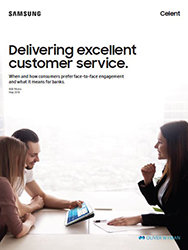There are few financial institutions left in the U.S. that haven’t focused on implementing mobile banking technology. These projects weren’t simple, but they were table stakes, and they usually focused either on providing scaled-down versions of the PC experience, or enabling customers to perform basic transactions remotely — or both.
But the role of the branch is changing from transactional to advisory, which requires banks to redesign business process and technology deployments. To set itself apart from online-only banks, the bank of the future will leverage mobility for much more than convenience and remote access. They’ll use it to create sophisticated, personalized experiences in the branch that turn casual customers into lifelong brand advocates.
Branch Experiences Still Matter
Your first thought may be that investing in the branch experience is a foolhardy focus in 2018. It’s true that self-serve capabilities are vitally important, which is why banks have been investing so heavily in them. But a recent Celent report found that, regardless of age or income, 77 percent of adults say they still prefer face-to-face engagement with their bank for substantive conversations, such as getting advice, setting goals and applying for new accounts or loans.
And when customers make the effort to come into a branch, the experience they have can forever shape their relationship with that bank. Almost half (47 percent) of customers say they will switch banks if they encounter a poor branch experience. It doesn’t take much to earn that distinction — it may simply mean there was a long wait or the staff wasn’t knowledgeable enough.
When asked what type of new experiences customers would like to see in their bank branches, half or more cited the following, in ranked order starting with the highest:
-
A banker greets customers by name and is prepared for their arrival, even though they have not yet met.
-
Using a mobile app, customers can check in at a branch, see how long their wait will be and compare wait times at different branches.
-
Customers can make an appointment with a banker using a mobile app, the bank’s website or an ATM.
-
The bank installs interactive touchscreen displays, so customers can explore offers, ask questions and get advice while they’re waiting.
-
Tablets are available for customers’ use, to explore banking services while they wait.
In other words, customers want banks to show a general regard for their time and to provide unobstructed access to the information they need, without having to navigate long lines or shuffle through various brochures.
Even more importantly, they want to have a personalized experience with a bank representative who’s knowledgeable about their finances, preferences, life stage and needs. And that makes sense: something as personal as our finances deserve a highly personal approach.
Activating the Entire Branch to Provide a Breakthrough Experience
Of course, the solution is not simply expecting your branch employees to memorize the names, faces and recent transactions of each customer. It involves leveraging mobile technology throughout the branch to give associates the tools and information they need to give customers a high-touch, personalized experience.
Creating Personalized Customer Experiences
Get your free guide to when, how and why consumers want face-to-face interaction with their banks. Download Now
It’s time to stop thinking of the branch as a place where learning and engagement happen in a few small pods — at loan officers’ desks or tellers’ windows. Instead, the bank of the future must activate the entire branch to engage the customer from the moment they step through the door.
A Banker’s Role in the Mobile-First Branch
This begins with a cultural shift. In the same way retail brands often station associates on the front lines to mingle and interact with customers as they shop, banks will deploy customer service personnel equipped with mobile devices into their entry and waiting areas.
When a customer arrives at the bank campus, digital sensors should recognize the customer’s mobile device and alert a greeter that the customer is entering. Equipped with the customer’s name and important account history, the greeter can give the customer a personalized greeting and begin the process of learning about the need that brought them into the branch. They can even suggest offers or products the customer might be interested in.
Of course, enabling this kind of full-service mobile approach means giving associates access to work portals, CRM and product information from their mobile devices. They’ll further need the ability to complete transactions, including accepting payments and conducting account onboarding from their mobile devices, even if it means ultimately docking their device to a larger monitor.
But no interaction is a one-way conversation, so it’s ideal to close the circle by giving associates the ability to deliver marketing and product information to customers on their own devices, as well as to interact with customer devices for authentication purposes.
Operationally, it’s also vital that the mobile bank employee be able to communicate hands-free, both with their customers and their colleagues. They’ll need to receive discrete notifications so that any direction or alerts aren’t displayed to customers who may be sharing their mobile devices.
Finally, when the customer reaches their final point of contact, whether that’s a loan officer or other specialized bank personnel, that person should be aware of everything the customer has experienced up to this point so that the conversation continues seamlessly. This reduces the fatigue of being handed from one person to another and also saves time for the banker and customer alike.
The Role of Self Service
Of course, busier branches will need additional self-serve support so customers can sign up for a place in line and get information while they wait. Even these experiences can be personalized for the customer by gearing information and cross-selling to products and services the customer may be interested in, based on their history.
All of these systems — both human-led and automated — must work together in a seamless handoff to create an efficient, highly personalized experience that will deepen brand loyalty and trust.
For the bank of the future, the mobile journey is only just beginning. The next step is using the strength and portability of mobile to deliver personalized service when customers want it the most — when they’re face-to-face with another person.
Looking for more exciting technology for the finance world? Explore our full line of financial technology solutions.









